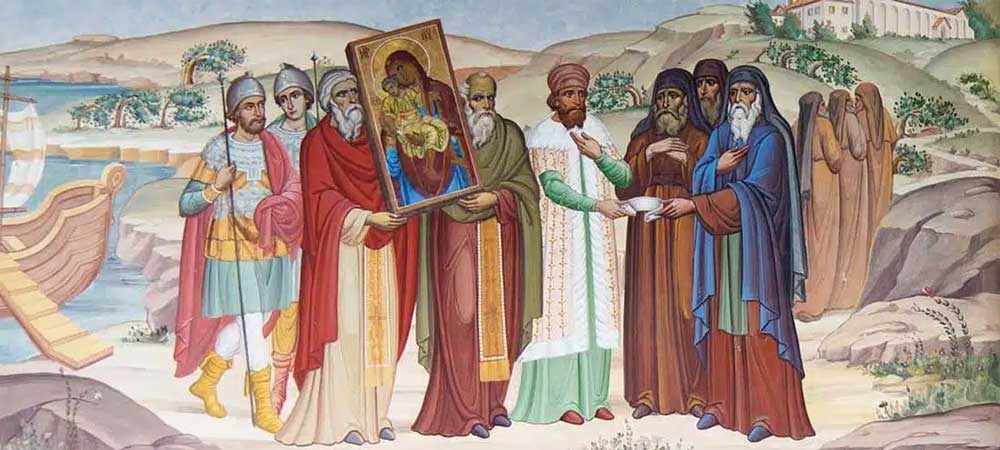Saint Ignatius the God’s Bearer
 Saint Ignatius the God-bearer, studied under the Evangelist John the Theologian. His name, which in Latin is pronounced as ignis, means fire and reveals the desire that burned him for Christ, to such an extent that he received the nickname theophoros. Tradition interpreted the nickname “theophoros” with two versions: a) that after his martyrdom the name of Christ was found engraved in golden letters on his heart and b) that he was the child that Christ carried in his arms, according to the narration of the Gospel according to Matthew (Matthew 18,1).
Saint Ignatius the God-bearer, studied under the Evangelist John the Theologian. His name, which in Latin is pronounced as ignis, means fire and reveals the desire that burned him for Christ, to such an extent that he received the nickname theophoros. Tradition interpreted the nickname “theophoros” with two versions: a) that after his martyrdom the name of Christ was found engraved in golden letters on his heart and b) that he was the child that Christ carried in his arms, according to the narration of the Gospel according to Matthew (Matthew 18,1).
Many decades of the life and activity of Saint Ignatius would have remained in obscurity if he had died on the episcopal throne and would have been known only in the episcopal lists of Eusebius.
During the persecution of Domitian (81-96) St. Ignatius encouraged many confessors to despise tortures and trials that last only for a moment and gain eternal life. After the persecution stopped, St. Ignatius laid the foundations of the organization of the Church and demonstrated that the Grace given to the Apostles on the day of Pentecost remains and is extended to the episcopal function even though the Apostles had now emigrated.
Afterwards, when Trajan was restored to the imperial throne, he at first left the Christians alone because he was at war with the barbarians. After his victory over the Scythians and Dacians he decided to subjugate all his subjects by leading them to worship idols and the emperor. Refusal to worship the aforementioned would incur the death penalty.
Around 113, Trajan campaigned against the Armenians and Parthians and on the way stopped briefly at Antioch where he began a local persecution against the Christians. There Saint Ignatius, after first being arrested, presented himself before the emperor and confessed his faith in Christ, he did not hesitate to mock the superstition of the mighty emperor, who invoked vain and false entities to protect his armies.
Then the saint said goodbye to his Church and was taken captive to Rome, after first passing through Smyrna, where he met his classmate Polycarp, the bishop of Smyrna, giving the people the appropriate admonitions. In Rome, where his journey ended, he was received by the faithful of the capital. His martyrdom took place in the arena of the Roman stadium, where wild lions fell upon him and devoured him, leaving only the large bones as a remnant, which some believers collected and carried to Antioch, where the Christians received them solemnly and the honest relics emerged as a source of miracles and spiritual consolation.
Saint Ignatius the God-bearer, the second bishop of Antioch with his episcopate beginning in AD 70. he was a Father and Teacher of the Church and the first great theologian of the Church after the Apostles. His acquaintance with the apostles is certain. The environment in which he was born and educated was probably Greek, as evidenced by the developed linguistic style of his Epistles, because Ignatius’ texts presuppose not only good education but also remarkable writing talent. In Antioch he had the opportunity to get to know the philosophical currents of his time.
At what age he became a bishop is not known. What is certain is that his prestige and spiritual authority went beyond the borders of Antioch reaching the borders of Syria, while his fame was even wider. He was, in short, a bishop of ecumenical character.
With Ignatius the God-bearing, the Church proceeds with the theological foundation of its course. The theology of Ignatius is genuine and became the philosophy, ethos and Tradition of the Church, because it is pastoral and constitutes an expression and continuation of the apostolic tradition. The theology of Ignatius can be divided into three points: a) the theology of the episcopal liturgy, b) the theology of the unity of the Church and c) the theology of eucharistic realism.
Before reaching the end of his life, he wrote 7 letters, which are preserved to this day: a) the one to the Ephesians, b) the one to the Magnesians, c) the one to the Trallians, d) the one to the Romans, e) the one to the Philadelphians, f) the to Smyrnaeans and g) the letter to Polykarpon. Six of them have as their central theme the unity of the Church, which he points out because of the danger of sects and emphasizes the unity and rallying of the multitude of believers around the bishop.
